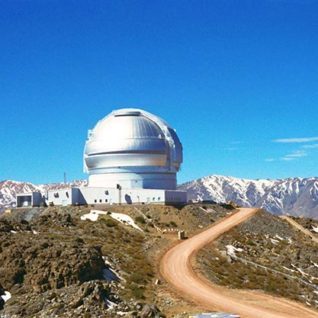
The Astronomy in Chile Educator Ambassadors Program (ACEAP) is a collaboration between AUI, the National Radio Astronomy Observatory, AURA, National Optical Astronomy Observatory, and Gemini Observatory, and is supported by the National Science Foundation (NSF 1439408 and 1723697). The Program brings amateur astronomers, planetarium personnel, and K-16 formal and informal astronomy educators to US astronomy facilities in Chile. While at these facilities, ACEAP Ambassadors will receive extensive training about the instruments, the science, data products, and communicating science, technology, engineering, and mathematics (STEM) concepts. When they return home, the Ambassadors will share their experiences and observatory resources with schools and community groups across the US.
ACEAP Goals
Goal 1
Inform amateur astronomers, planetarium personnel, and K-college astronomy educators about astronomy facilities in Chile, the nature of work being done by scientists and engineers at the facilities, and how they can access and use data being collected and other resources from these observatories.
Goal 2
Create a core group of individuals (Ambassadors) who will broadly disseminate NRAO, NOAO, and Gemini information and resources to the general public and K–college learners.

ACEAP in the The 365 Days of Astronomy podcast !!
The 365 Days of Astronomy podcast launched in 2009 as part of the International Year of Astronomy. Since then, this podcast has interview and promote science and education around the globe. This past April 9th, 2022, Tim Spuck, PI for the ACEAP project, and the STEM...

Sian Proctor is the first African American woman to pilot a spacecraft. (Inspiration4)
Sian Proctor, the first African American woman to pilot a spacecraft: ‘The reality is that solving for space solves for Earth’ @DrSianProctor made history in September as a member of the first all-civilian orbital spaceflight, SpaceX’s Inspiration4 mission More here:...
Background
The U.S. has invested hundreds of millions of dollars in astronomy infrastructure in Chile, and tens of millions of dollars more each year for operations, and new projects are already under way. In addition to the Cerro Tololo Inter-American Observatory (CTIO), Gemini-South Observatory, and the Atacama Large Millimeter-submillimeter Array (ALMA), the National Science Foundation (NSF), in collaboration with the U.S. Department of Energy, has begun construction of the Large Synoptic Survey Telescope (LSST). U.S. institutions are also leading an international collaboration to build the Giant Magellan Telescope (GMT) in Chile. Between LSST and GMT alone, nearly $1.5 billion will be invested over the next eight years. By the year 2022, 70% of the world’s astronomy infrastructure will be located in Chile. Why is this the case?
An informed citizenry is important to the success of any national endeavor, including those focusing on the advancement of science, technology, engineering, and mathematics (STEM). The U.S. is making significant investments in astronomy in Chile, and those investments are yielding incredible new discoveries and advancements in science and technology. Thanks to support from the National Science Foundation, ACEAP will develop a core group of individuals with a deep understanding of NSF supported facilities in Chile, and enhanced STEM communication skills needed to share this knowledge with a diverse public.






Becoming an ACEAP Ambassador
As we move toward a long-term sustainable model to support ACEAP, and in an effort to broaden participation, each ACEAP 10-person cohort includes those supported by NSF grant funding, as well as individuals who are fully supported by their institution and/or personal funds. It is anticipated that 6 of the ACEAP Ambassador positions will be supported by grant funding and the remaining 4 will be fully supported via institutional and/or personal funding. PLEASE NOTE: Regardless of the source of an Ambassador’s support, requirements remain the same, and all Ambassadors will receive the $500 stipend for completion of their 7 required outreach activities.
Who may apply? Anyone may apply for the four positions fully supported by your institution and/or personal funding. This includes US as well as non-US citizens, regardless of geographic location. The remaining six slots are restricted to U.S. citizens and permanent residents who are amateur astronomers, K through college formal and informal educators who teach astronomy as part of their curriculum or program, planetarium educators, or those working in the area of astronomy communications.
If selected, what can you expect? A total of nine ambassadors will be selected each year from across the U.S. and its territories. Throughout late winter and early spring, Ambassadors will attend a series of virtual meetings and online training to prepare them for the expedition.
The 2017 ACEAP team will travel to Chile for a nine-day expedition. Ambassadors will visit ALMA, CTIO, and Gemini facilities for a “once in a lifetime” behind the scenes experience. During the visits, observatory personnel will share an overview of observing facilities, discuss current science and engineering taking place at the facilities, and show Ambassadors how to access the observatory data archives for research projects and other purposes. Participants will also experience Chilean culture and society, and the astro-tourism industry that has emerged in Chile. In addition to the professional facilities, ACEAP Ambassadors will visit smaller amateur-public observatories. Weather permitting, nighttime observing opportunities will be made available.
“As a research astronomer, I always thought of space as data, an array of numbers. It wasn’t until I participated in ACEAP and I saw the Chilean sky that I realized how beautiful the night sky really is.”
— Moiya McTier, ACEAP 2018






